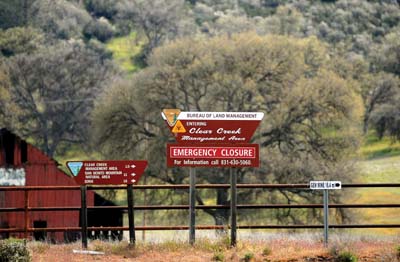For more than two years, Clear Creek Management Area, 70,000
acres managed by the Bureau of Land Management in southern San
Benito County and western Fresno County, has been temporarily
closed to the public after a U.S. Environmental Protection Agency
study discovered high concentrations of asbestos in the area due to
its 31,000 acre serpentine deposit, the largest in the United
States.
Editor’s note: The full version of this story can be seen in the Pinnacle on Friday. It is the first in a two-part series.
For more than two years, Clear Creek Management Area, 70,000 acres managed by the Bureau of Land Management in southern San Benito County and western Fresno County, has been temporarily closed to the public after a U.S. Environmental Protection Agency study discovered high concentrations of asbestos in the area due to its 31,000 acre serpentine deposit, the largest in the United States.
All roads in the area stayed closed until last month, when the San Benito County Board of Supervisors voted unanimously to reopen the county roads near the federal lands, hoping to avoid a lawsuit by landowners within the recreational area. But the rest of the area has stayed closed.
The BLM released a 700-page environmental impact statement late last year and outlined seven alternatives on how to handle the area, ranging from doing nothing to closing it for good. Its leaders have indicated they prefer Alternative E, allowing non-motorized use of the area. Motorized vehicles driving over the lands are known to amplify asbestos exposure.
After its release, the BLM took public comment on the EIS and is establishing a plan based on the comments and the agency’s report to determine the best way to move forward. The public comment period ended April 19.
“We will take those and meld those up and look at the alternatives again – do some tweaking and then arrive at a proposed plan at the end of June or the first of July,” BLM Hollister Field Manager Rick Cooper said. “Then with that plan we have to run through some analyzing and we could propose the plan to the public by September.”
The EPA study, started in 2004 and taking four years to complete, discovered concentrations of asbestos’ chrysotile form that were higher than the EPA’s recommended exposure of 1 in 10,000 to 1 in a million.
The study showed that 8 percent of the asbestos findings included amphiboles, which is believed to be the cause of the highest risk of mesothelioma and future cancer, EPA project manager Gere Johnson said. But all types of asbestos are carcinogenic.
The land was flagged as an area that, if used in high amounts, could cause cancer in the future, and the EPA recommended the BLM reconsider how it made the land available.
“The asbestos exposures that EPA measured at CCMA are high and the resulting health risk are of concern,” the EPA wrote in its report.
Cooper, who was appointed to the manager position in 2006, made the final decision to close the area until the BLM could come up with a plan to reduce the risk, he said.
“What I was looking at – we have a body of information that says we have a high level of concentration and if you go out there and play out there you will be exposed to high levels,” he said. “So based on that – that was my reasoning for my decision of closing the area. It’s also supported my basis for my preferred alternative in the EIS.”
But the study has caused debate on whether the chrysotile form of asbestos found is actually dangerous.
Expert weighs in
According to the founder and President of Aeolus, a environmental consulting firm in the Bay Area, Wayne Berman, Ph.D, it is, but it’s just not as big of a risk as amphiboles.
“In research that I’ve done, fiber to fiber amphiboles are more potent and more hazardous than that of chrysotile, especially in regards to mesothelioma,” Berman said.
chrysotile, though, is just as potent in other types of cancer, Berman said.
In the Clear Creek area, chrysotile makes up 92 percent of the asbestos, but the 8 percent of amphiboles can be extremely dangerous, Berman said.
“If it truly is amphibole, then at 8 percent it would dominate the overall risk,” he said.
Despite the asbestos risk, the closure of the public but government-managed land in May 2008 caused an outcry from the off-highway vehicle community and county representatives. Closing the land was done for the public’s safety, but some of its users don’t believe there is a health risk.
With an outpouring of letters, rallies and vocal Internet blog forums, the OHV community is making sure its voice is heard.
The users have defended the public’s right to use the land and, in the process, have dismissed the EPA study.
“There is not one, not one case of someone who has gotten sick,” said Ed Tobin, an off-road enthusiast who blogs about the CCMA. “If there was somebody that got sick we (the off road community) would know about it.”
Tobin, who will be 60 this year, has been riding in the area since 1973 and he doesn’t believe he has ever put himself at a health risk, he said.
“I’ve gone to doctors and professionals and I do not believe I am putting myself at risk,” he said. “I probably have more time at Clear Creek than 95 percent of people that recreate there, and I am not sick.”
Tobin believes that the EPA report is misguided, he said. He contended the report didn’t follow the BLM’s guidelines for riding and the agency didn’t test during the right time of the year.
Andy Bajka, founder of South Bay Riders, agrees. He said riders don’t follow directly behind each other.
“When you do a scientific report you aren’t supposed to stack the cards to come out with the info you need. And their study was done in a impossible and unrealistic way.”
For the full story, see the Pinnacle on Friday. For Part 2 of this series, see the following week’s Pinnacle.










